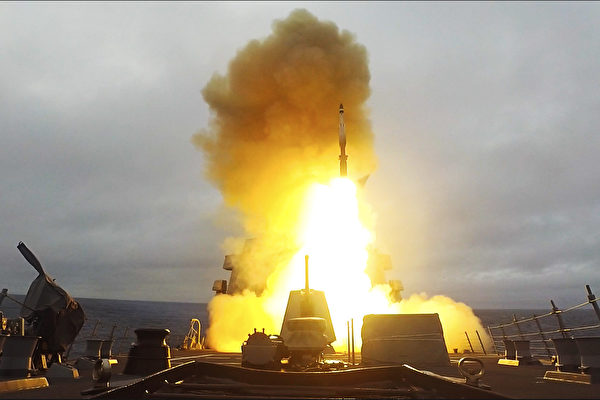Experts have indicated that ballistic missile defense systems have faced complex and high-risk situations for the first time in Israel, the Red Sea, and Ukraine, achieving significant successes. This has led to an acceleration in investment in such systems by countries worldwide.
In the recent incident, Iranian forces launched up to 120 medium-range ballistic missiles towards Israel on April 13th. However, the American SM-3 missile and Israel’s Arrow air defense system managed to intercept and destroy most of the Iranian missiles, leaving only drones and smaller threats to be taken down by Israel’s Iron Dome system.
In previous months, intercepting missiles launched from U.S. Navy destroyers successfully targeted and destroyed anti-ship ballistic missiles used by Houthi militants.
In Ukraine, the U.S.-made MIM-104 Patriot missile system also intercepted Russian Iskander ballistic missiles and Khinzal hypersonic missiles.
Several experts have informed Reuters that more countries are preparing to invest in ballistic missile defense systems, potentially leading to unexpected windfalls for defense companies like Lockheed Martin and Raytheon.
Ankit Panda, an expert from the Carnegie Endowment for International Peace, stated, “It is undeniable that any technically affluent country will continue to invest in missile defense.”
European countries including the Netherlands, Germany, Sweden, and Poland have already been using the Patriot missile system manufactured by Raytheon, which is the most common advanced ballistic missile defense system in the West.
Saudi Arabia has long utilized the Patriot missiles to fend off attacks by Houthi militants. Both Saudi Arabia and the United Arab Emirates employ the THAAD system produced by Lockheed Martin. Kuwait, Qatar, and Bahrain also possess Patriots, while Oman has shown interest in missile defense systems.
Lockheed Martin secured a $17.7 billion contract in April in the U.S. to provide a new generation of interceptors for the Ground-based Midcourse Defense system aimed at shooting down intercontinental ballistic missiles targeting the U.S.
With China heavily investing in ballistic missile development, the surge in procurement of these defense systems is particularly intense in Asia.
A Pentagon report from 2023 revealed that the Chinese Rocket Force possesses around 500 DF-26 ballistic missiles, capable of striking targets thousands of kilometers away.
Jeffrey Lewis from the Middlebury Institute of International Studies’ East Asia Nonproliferation Project stated, “In the Pacific region, there will be increased focus on missile defense, which will drive China to build more missile systems.”
He added, “Countries will also seek to acquire offensive missiles because they see other nations using these missiles… This will drive the demand for missile defense systems.”
The principle of ballistic missile defense systems involves detecting and intercepting weapons during enemy launches or missile flights, using land-based radars to guide interceptor missiles to target and destroy them.
Interceptions can take place in the atmosphere or outer space, requiring different equipment for each domain. For example, missile fins are ineffective outside the atmosphere, thus requiring small steering rockets on interceptors for outer atmosphere engagements.
Lewis mentioned that in the Indo-Pacific region, wealthier countries like Japan, Australia, and South Korea are gearing up to increase investments in missile defense, as nearly all countries in Asia are acquiring missiles.
The Japanese Ministry of Defense stated that Japan “urgently needs to strengthen defense capabilities fundamentally, including comprehensive air defense and missile defense.” Japan plans to introduce the latest models of the Patriot system, upgrade radars, and enhance naval anti-missile capabilities.
In a statement, the South Korean Ministry of National Defense announced a 12% increase in funding for its air defense and missile defense systems in the latest defense budget.
The South Korean Ministry of National Defense emphasized the importance of possessing ballistic missile defense systems in responding to increasingly complex missile threats, highlighted by conflicts like the Ukraine crisis and Russia-Ukraine war.
Australia recently signed a $500 million AUD (approximately $3.28 billion USD) contract with Lockheed Martin for a joint air battle management system to track and destroy aircraft and missiles.
The costs of anti-ballistic missile systems are often much higher than ballistic missiles themselves, requiring high-performance computers, over-the-horizon radars, and interceptor missiles as large as utility poles, which could total billions of dollars. For example, in 2022, the U.S. approved a $5.3 billion deal to sell Patriots and THAAD systems to Saudi Arabia.
However, for many countries, this investment is deemed necessary.
Former Commander of the Japan Maritime Self-Defense Force Fleet, Yoji Kanda, said, “In a wartime economy, cheaper is better. But sometimes, we need to protect critical infrastructure or command center at all costs. Because without them, we will be defeated.”
China has also developed maneuverable warheads for targeting maritime targets. Until recently, these anti-ship ballistic missiles had not been utilized in combat until Houthi militants in Yemen began firing Iranian-manufactured anti-ship ballistic missiles towards ships in the Red Sea at the end of 2023. The global community is closely monitoring the effectiveness of missile defense systems against such weapons.
According to the U.S. Central Command, at least 85 anti-ship ballistic missiles have been launched in the Middle East between November of last year and April of this year, with 20 being intercepted. The Central Command stated that missiles not posing a threat were not intercepted, and most of the unintercepted missiles caused no harm.
Chinese missile technology remains highly classified, making it difficult to ascertain if intercepting Chinese missiles would be more challenging given their significant investments.
Lewis highlighted that for many countries, investing in missile defense systems carries both political and practical benefits.
He said, “All defense procurement decisions are ultimately political. The politics are actually quite simple – when asked if you want to defend your country, the winning answer is always ‘yes’.”

